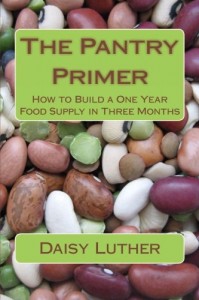If you're new here, you may want to subscribe to my RSS feed. Thanks for visiting!
Food storage calculators recommend 300 pounds of grains per person for a one year supply. For a family of four, that is a whopping 1200 pounds of food that you should store if you are trying to build a one year pantry!
That sounds like a really daunting number until you remember that it is divided over many different items. To name a few:
- Rice
- Flour
- Wheat
- Quinoa
- Couscous
- Cornmeal
- Barley
- Oats
- Pasta
You should divide up your grain storage based upon your family’s preferences. After all, if only one person likes rice, the rest of you won’t want to be stuck having it at every other meal if you must live off your stockpile for a year!
Most grains can be purchased in very large quantities at a greatly reduced price. When purchasing in amounts over 20 pounds, your food storage methods become particularly important. When deciding what storage methods you intend to use, you must ask yourself whether you intend for these goods to be your long term food storage, remaining untouched unless disaster strikes, or whether you intend to rotate them from the pantry to the kitchen, using them and replenishing your pantry as needed. Check out this detailed information on food storage methods.
Want to learn more? My new book is now available!
Lots of us like to have hard copies of information that we’ve found helpful. Because of this, I’ve expanded on the information included in this series and put it all in one handy primer, available on Amazon.

















10 Responses
I just love my grains………I love cocoa too!!
http://www.delightedmomma.com/2013/10/homemade-dark-chocolate-paleo.html?m=1
Don’t forget the chocolate ……keep preppin’ 🙂
I also include millet with my grains.
Daisy, I am curious, do you think that you, yourself, actually eat 300 lbs of grains each year? I have asked myself that question also. I guess it is possible if I were to calculate the flour in the bread I eat in a year. Otherwise, looking at my winter store of grain, and knowing how often I replenish it, it just does not seem like I eat that much.
What do you think?
I’ve wondered this myself, Half-Kin. I think a lot of what we eat is likely flour as an ingredient in breads, pizza dough, tortillas, etc. I would be comfortable with a lesser amount than 300 pounds in normal, everyday life. But in a disaster scenario, you will be calling on your body for more. The additional calories from carbs might come in very handy if you are chopping wood, farming, and repairing your home.
Best wishes ~
Daisy
Daisy, I fully agree with your reply to HalfKin. Caloric intake will need to increase due to increased activity levels, and grains are a good way to do that in a healthy way. I introduced my family to quinoa, coucous, bulgur wheat, barley perhaps a year ago, and have gotten them accustomed to eating it, they aren’t crazy about the quinoa, but they do like bulgur wheat. I was just introduced to the meatless sausage using oats, and that also got a positive reception, even on my first attempt (need a lot of tweaking on the spices, myself)!
There probably are two (2) pantries.
Pantry 1–this is what you use when times are ok and the economy is so-so. This pantry has lots of flexibility because you can use it, but you can also go to the store and get items needed. It is for food, but not an emergency.
Pantry 2–is the emergency one. This one may be boring, but you need to look at your favorite 5-6 main food items for survival. Rice is a good one and folks will eat it in an economic collapse. This is my pantry. I am stocking for the bad times, at least how I perceive them. For me,
.Beans
.Oats
.Rice
.potato flakes
.powdered milk
.Thrive fruit stuff
.canned goods like soups
.cocao and coffee
.heirloom seeds
.spices for the above
In garden, heavily into tubers mainly Jerusalem Artichoke and Potatoes.
In freezer, always fill it full in October with local beef and frozen sweet corn.
That is my take. My pantry is for survival when that day comes with hyperinflation and food shortages. Good luck to all.
Be careful with storing Heirloom seeds. I bought a #10 can with a variety of seeds the were guaranteed for a 20 year storage life back before Y2K. This spring, I decided to open the can and plant the seeds. They were nearly all useless even though they had been stored correctly. I was really glad that I tried opening them. It would have been really tragic if I found myself in a situation where I was truly counting on those seeds to feed my family and found them to be a total loss. I will be replacing them, but instead of storing them, I will plant them and rotate them properly from year to year, even if on a much smaller scale then we would need in a long-term disaster situation.
what do you you mean “nearly all useless? None germinated or were moldy or did not grow properly or did not have any veggies? And if it was no germination , did you try more than one method to get them to germinate or did you just put them in a hole and none came up so you have concluded they were useless…this is not meant as a slam on you at all, you are one of the first persons I have heard who has planted their seeds bought in a #10 can and we all need to know what methods you used or if you are correct and they are useless. If so we may need to be storing seeds differently than the big can of seeds that are being hawked on many prep store sites as good for 25 years. thanks.
Let me clarify, I grow a big garden every year, and save seed from my roma’s and squash and cucumbers, peppers, zucchini and the like.So I will be good even if that can -o- seeds is a total bust, but there are other folks that dont have a garden at all except maybe a planter or two of tomatoes That they buy in pots at the garden center each spring, and that would really be depending on those seeds for their entire garden.That could mean life or death to them to not be able to get them to grow. And even though I have about a 1/5 acre garden and save my seeds year to year, there just is not enough room to plant all the veggies that we like, and lets face it, there are some veggies that taste about the same store bought as home grown,(carrots and onions come to mind). So I dont buy a lot of seed for those year to year so I can have just one more row of sweet corn or tomatoes and I was counting on the #10 can of seeds for those favorites that would be sorely missed if I could no longer buy them at the store.
The OP provided excellent information. However I don’t think it is a viable long term solution.
1) The top producing grains are all annuals. So they are tender to disruption of supply/growing more so than many other products in a SHTF situation. Not only that but unless you are sitting in the grain belt, supply is distribution dependent.
2) Relatively speaking long term storage of 300#/person of grains is an expensive proposition/calorie. Even done well it is susceptible to spoilage.
3) Growing enough grain for a family of four would take 2-3 acres. That’s space most people don’t have. You certainly won’t make it tearing up your average suburban lawn.
4) Processing can be tedious.
5) Consumption of too much grain, even the non-GMO variety, have certain health drawbacks.
If you look historically our grain centered food habits are a late arrival. In the period just before the Civil War I would hazard a family of 5-6 people would not consume more than 300# of various grains all year. Without the modern infrastructure we have today getting grain was a backbreaking, time consuming, and expensive proposition. Our ancestors consumed a very different diet high in meats, fats, vegetables.
My point? If your family of 4 just consumed your last 50# bag of grain and there ain’t no more a’comin what are you going to do? One needs to seriously consider now what dietary actions you would take in a grain reduced environment.
Hi Daisy,
I loved your article about healthier eating on a budget…would definitely suggest adding lentils and chickpeas to the list…lentils and chickpeas are two of the foods that you can eat daily for very little and make delicious meals with easily that provide alot of nutrition. Thank-you for doing what you do. You are awesome.